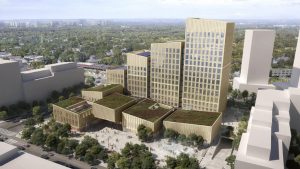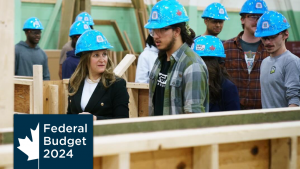Governments will play a key role as the world’s cities strive to attain ever-greater sustainability but the marketplace, eager for profits, will also drive the transition to a green economy.
Those dual forces were identified by an international panel assembled for a webinar Sept. 23 by Holcim, the global building materials giant, to mark Climate Week NYC. The topic on the table was Accelerating Green Building for Resilient Cities.
Bertrand Piccard, chairman of the Swiss agency Solar Impulse Foundation, said proponents in the green building sector need to aggressively champion the notion that the technologies needed for the transition are now available and many are inexpensive. His foundation has identified 1,300 technological solutions to protect the environment.
“From five years ago, the increase in productivity has been spectacular,” said Piccard. “You know the price of solar photovoltaic electricity has been divided by 30 in the last 15 years. Now we can finally tell people that these technologies are profitable, but they are still in the mindset that it is expensive.
“We have to show the trend and the trend is not only new technologies, but it’s really the decrease of price which increases the profitability.”
The language of the world today is about job creation, about profits – that speaks more clearly to many entrepreneurs than protecting the environment, Piccard said.
“This is why it is so important that the mindset of the people changes, and that the people are informed about these technologies,” he explained.
Other panellists were Deborah Weintraub, chief deputy engineer for the City of Los Angeles; Cristina Gamboa, CEO of the World Green Building Council; Kate Ascher, professor of urban development at Columbia University; Eduardo Pizarro, a Brazil-based architecture professor; and Jamie Gentoso, global head of products at Holcim.
Gentoso addressed the immensity of the issue, noting that more than half the world’s population lives in a city today, with trends indicating by 2050 there will be 2.5 billion more city dwellers. To deal with those citizens, an estimated 60 per cent of the infrastructure that will be needed still remains to be built.
“That means how we build our cities is critical,” she said. “Buildings are the single largest contributor to CO2, so how we design, what materials are specified and what we build matters.
“We must consider the full building performance, not just the footprint of individual materials, but a full solution that can provide an efficient, resilient, durable and a circular life.”
As an example of an efficient solution, Gentoso noted her firm has completed the world’s first 3D printed school, manufactured out of concrete in Malawi. The process took only 18 hours and used 70 per cent less materials than traditional building techniques.
Ascher identified four categories where governments can push solutions ahead by mandating or providing incentives for progress. First is energy efficiency and energy usage — New York City has taken strides in mandating targets. Next is electrification – the buildings of tomorrow will be electrified and be plugged into a clean grid. Third is using high-performance materials, and fourth is encouraging adaptive reuse.“It’s about encouraging people, businesses, developers not to tear down existing buildings, but rather to reuse them,” said Ascher.
“I think government should be on the hook to encourage that kind of behaviour as well.”
Weintraub said the City of Los Angeles has been on a 20-year journey to increase efficiency and environmental performance. Through its green new deal it is slowly increasing the standards that it is asking builders to meet.
“We just keep pushing the bar higher and higher,” she said. “We’re now piloting some net-zero energy projects, and every project we do is a learning experience for us, and for our contractors we work with, who are typically pretty small contractors. There’s a lot of hand-holding.”
Weintraub too argued that cities have to stop building new, with existing buildings containing a lot of embodied carbon.
Gamboa said beyond the power of municipal governments to mandate standards and create policy, they are also major real estate and infrastructure asset owners with the power to demand efficiencies on their projects.
“We need more lifecycle analysis, we need more environmental product declarations,” she said.
Pizarro said architects will play an important role in the transformation of the built environment, asserting that all the smart technology in the world will not work in a poorly designed building. And he also urged stakeholders to pay more attention to the spaces between buildings.
“Instead of seeing these spaces as left over, voids, we should see them as spaces for opportunities for wind, sun, people, political demonstrations. Then we could really design or redesign the spaces in order to unveil that hidden power,” he said.
Follow the author on Twitter @DonWall_DCN.











Recent Comments
comments for this post are closed